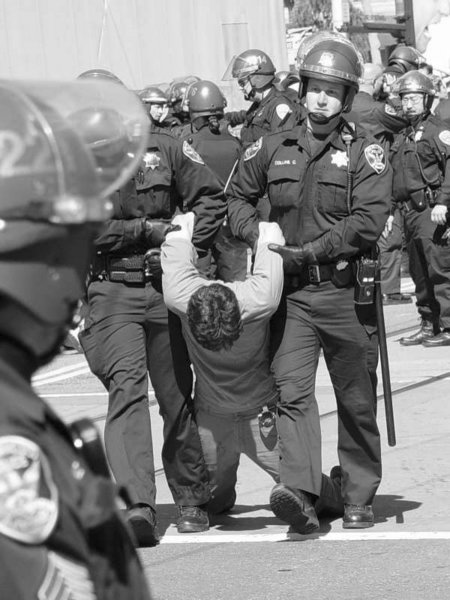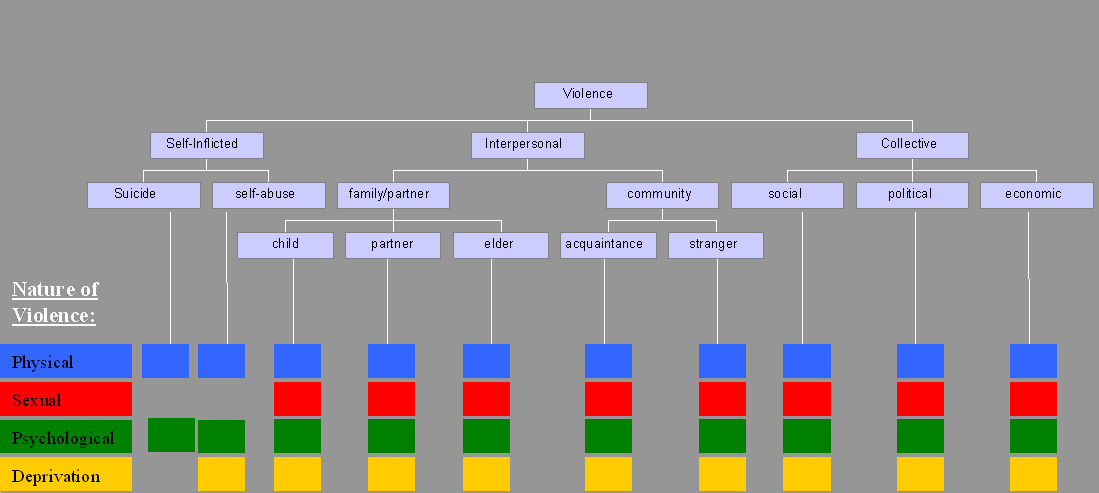|
Defensivism
Defensivism is a philosophical standpoint related in spirit to the non-aggression principle. It is a halfway point between other combat or violence based philosophies, such as just war and pacifism. Concept Defensivism has a standpoint that only defensive actions are moral. One may move to aid someone in immediate danger or protect oneself from immediate harm. To a country, it holds that a military force may never leave its own borders except to move to the aid of someone else, and in such a situation, that it may protect from harm only if it is specifically invited to, with no aggressive action taken. In principle, any form of pre-emptive strike, capture, revenge, or firing the first actual shot or throwing the first actual blow is against the defensivist standpoint. If an action must be halted to stop an aggressor from achieving a goal to harm, defensivism allows for actions that assist in removing an imminent threat such as searching an airline passenger for bombs, stopping a ... [...More Info...] [...Related Items...] OR: [Wikipedia] [Google] [Baidu] |
Pacifism
Pacifism is the opposition to war or violence. The word ''pacifism'' was coined by the French peace campaigner Émile Arnaud and adopted by other peace activists at the tenth Universal Peace Congress in Glasgow in 1901. A related term is ''ahimsa'' (to do no harm), which is a core philosophy in Hinduism, Buddhism, and Jainism. While modern connotations are recent, having been explicated since the 19th century, ancient references abound. In modern times, interest was revived by Leo Tolstoy in his late works, particularly in '' The Kingdom of God Is Within You''. Mahatma Gandhi propounded the practice of steadfast nonviolent opposition which he called " satyagraha", instrumental in its role in the Indian independence movement. Its effectiveness served as inspiration to Martin Luther King Jr., James Lawson, Mary and Charles Beard, James Bevel, Thích Nhất Hạnh,"Searching for the Enemy of Man", in Nhat Nanh, Ho Huu Tuong, Tam Ich, Bui Giang, Pham Cong Thien. ''Dialog ... [...More Info...] [...Related Items...] OR: [Wikipedia] [Google] [Baidu] |
Resistance Movement
A resistance movement is an organized group of people that tries to resist or try to overthrow a government or an occupying power, causing disruption and unrest in civil order and stability. Such a movement may seek to achieve its goals through either the use of violent or nonviolent resistance (sometimes called civil resistance), or the use of force, whether armed or unarmed. In many cases, as for example in the United States during the American Revolution, or in Norwegian resistance movement, Norway in the Second World War, a resistance movement may employ both violent and non-violent methods, usually operating under different organizations and acting in different phases or geographical areas within a country. Etymology The Oxford English Dictionary records use of the word "resistance" in the sense of organised opposition to an invader from 1862. The modern usage of the term "Resistance" became widespread from the self-designation of many movements during World War II, especially ... [...More Info...] [...Related Items...] OR: [Wikipedia] [Google] [Baidu] |
Pacifism
Pacifism is the opposition to war or violence. The word ''pacifism'' was coined by the French peace campaigner Émile Arnaud and adopted by other peace activists at the tenth Universal Peace Congress in Glasgow in 1901. A related term is ''ahimsa'' (to do no harm), which is a core philosophy in Hinduism, Buddhism, and Jainism. While modern connotations are recent, having been explicated since the 19th century, ancient references abound. In modern times, interest was revived by Leo Tolstoy in his late works, particularly in '' The Kingdom of God Is Within You''. Mahatma Gandhi propounded the practice of steadfast nonviolent opposition which he called " satyagraha", instrumental in its role in the Indian independence movement. Its effectiveness served as inspiration to Martin Luther King Jr., James Lawson, Mary and Charles Beard, James Bevel, Thích Nhất Hạnh,"Searching for the Enemy of Man", in Nhat Nanh, Ho Huu Tuong, Tam Ich, Bui Giang, Pham Cong Thien. ''Dialog ... [...More Info...] [...Related Items...] OR: [Wikipedia] [Google] [Baidu] |
Combat
Combat (French language, French for ''fight'') is a purposeful violent Conflict (process), conflict between multiple combatants with the intent to harm the opposition. Combat may be armed (using weapons) or unarmed (Hand-to-hand combat, not using weapons). Combat is resorted to either as a method of self-defense or to impose one's will upon others. An instance of combat can be a standalone confrontation or part of a wider conflict, and its scale can range from a fight between individuals to a war between organized groups. Combat may also be benign and recreational, as in the cases of combat sports and mock combat. Combat may comply with, or be in violation of, local or international laws regarding conflict. Examples of rules include the Geneva Conventions (covering the treatment of people in war), Middle Ages, medieval chivalry, the Marquess of Queensberry Rules (covering boxing), and the individual rulesets of various combat sports. Hand-to-hand combat Hand-to-hand combat (m ... [...More Info...] [...Related Items...] OR: [Wikipedia] [Google] [Baidu] |
Violence
Violence is characterized as the use of physical force by humans to cause harm to other living beings, or property, such as pain, injury, disablement, death, damage and destruction. The World Health Organization (WHO) defines violence as "the intentional use of physical force or power, threatened or actual, against oneself, another person, or against a group or community, which either results in or has a high likelihood of resulting in injury, death, psychological harm, maldevelopment, or deprivation"; it recognizes the need to include violence not resulting in injury or death. Categories The World Health Organization (WHO) divides violence into three broad categories: self-directed, interpersonal, and collective. This categorization differentiates between violence inflicted to and by oneself, by another individual or a small group, and by larger groups such as states. Alternatively, violence can primarily be classified as either instrumental or hostile. Self-in ... [...More Info...] [...Related Items...] OR: [Wikipedia] [Google] [Baidu] |
Just War
The just war theory () is a doctrine, also referred to as a tradition, of military ethics that aims to ensure that a war is morally justifiable through a series of criteria, all of which must be met for a war to be considered just. It has been studied by military leaders, theologians, ethicists and policymakers. The criteria are split into two groups: ("right to go to war") and ("right conduct in war"). There have been calls for the inclusion of a third category of just war theory ('' jus post bellum'') dealing with the morality of post-war settlement and reconstruction. The just war theory postulates the belief that war, while it is terrible but less so with the right conduct, is not always the worst option. The just war theory presents a justifiable means of war with justice being an objective of armed conflict. Important responsibilities, undesirable outcomes, or preventable atrocities may justify war. Opponents of the just war theory may either be inclined to a stricter ... [...More Info...] [...Related Items...] OR: [Wikipedia] [Google] [Baidu] |
Vladimir Lenin
Vladimir Ilyich Ulyanov ( 187021 January 1924), better known as Vladimir Lenin, was a Russian revolutionary, politician and political theorist. He was the first head of government of Soviet Russia from 1917 until Death and state funeral of Vladimir Lenin, his death in 1924, and of the Soviet Union from 1922 until his death. As the founder and leader of the Bolsheviks, Lenin led the October Revolution which established the world's first socialist state. His government won the Russian Civil War and created a one-party state under the Communist Party of the Soviet Union, Communist Party. Ideologically a Marxist, his developments to the ideology are called Leninism. Born into a middle-class family in Simbirsk in the Russian Empire, Lenin embraced revolutionary socialist politics after Aleksandr Ulyanov, his brother was executed in 1887 for plotting to assassinate Alexander III of Russia, the tsar. He was expelled from Kazan Imperial University for participating in student prote ... [...More Info...] [...Related Items...] OR: [Wikipedia] [Google] [Baidu] |
Alexander Svechin
Alexander Andreyevich Svechin (; 17 August 1878 – 28 July 1938) was a Russian and Soviet military leader, military writer, educator, and theorist, and author of the military classic work ''Strategy''. Early life He was born in Odessa, where his father was a general in the Imperial Russian Army. He was of Russian ethnicity. His elder brother Mikhail Svechin (1876–1969) was a cavalry officer in the ''cuirassiers'' who fought in the Russo-Japanese War and World War I, joined the White movement in the Russian Civil War and died in France in 1969. He studied at St. Petersburg Cadet Corps, then in the Mikhailovsky Artillery School. He graduated from the General Staff Academy in 1903. Career He participated in the Russo-Japanese War of 1904-1905 as a Company Commander in the 22nd Eastern Siberian Regiment, and subsequently as a staff officer at the headquarters of the 16th Army Corps, and a staff officer at the headquarters of the 3rd Manchurian Army. In 1915, he was assign ... [...More Info...] [...Related Items...] OR: [Wikipedia] [Google] [Baidu] |
Attrition Warfare
Attrition warfare is a form of military strategy in which one side attempts to gradually wear down its opponent to the point of collapse by inflicting continuous losses in personnel, materiel, and morale. The term ''attrition'' is derived from the Latin word , meaning "to wear down" or "to rub against", reflecting the grinding nature of the strategy. Strategic considerations Attrition warfare seeks to erode an opponent’s capacity to wage war by systematically destroying their military resources, morale, and logistics over time. This may involve guerrilla warfare, people's war, scorched earth tactics, or prolonged engagements short of a decisive battle. It contrasts with strategies such as blitzkrieg or force concentration, which aim to achieve rapid victory through overwhelming power in a single decisive engagement. As Clausewitz described, it is a strategy of exhausting the adversary’s will and capability to fight. A combatant facing a significant disadvantage may ... [...More Info...] [...Related Items...] OR: [Wikipedia] [Google] [Baidu] |
Self-defence In International Law
International law recognizes a right of self-defense according to the Chapter VII, Article 51 of the UN Charter, as the International Court of Justice (ICJ) affirmed in the '' Nicaragua Case'' on the use of force. Some commentators believe that the effect of Article 51 is only to preserve this right when an armed attack occurs, and that other acts of self-defence are banned by article 2(4).Randelzhofer, ''Article 2(4) in'' The Charter of the United Nations: A Commentary (1994). Another view is that Article 51 acknowledges the previously existing customary international law right and then proceeds to lay down procedures for the specific situation when an armed attack does occur. Under the latter interpretation, the legitimate use of self-defence in situations when an armed attack has not actually occurred is still permitted, as in the ''Caroline'' case noted below. Not every act of violence will constitute an armed attack. The ICJ has tried to clarify, in '' Nicaragua Case'', what ... [...More Info...] [...Related Items...] OR: [Wikipedia] [Google] [Baidu] |





